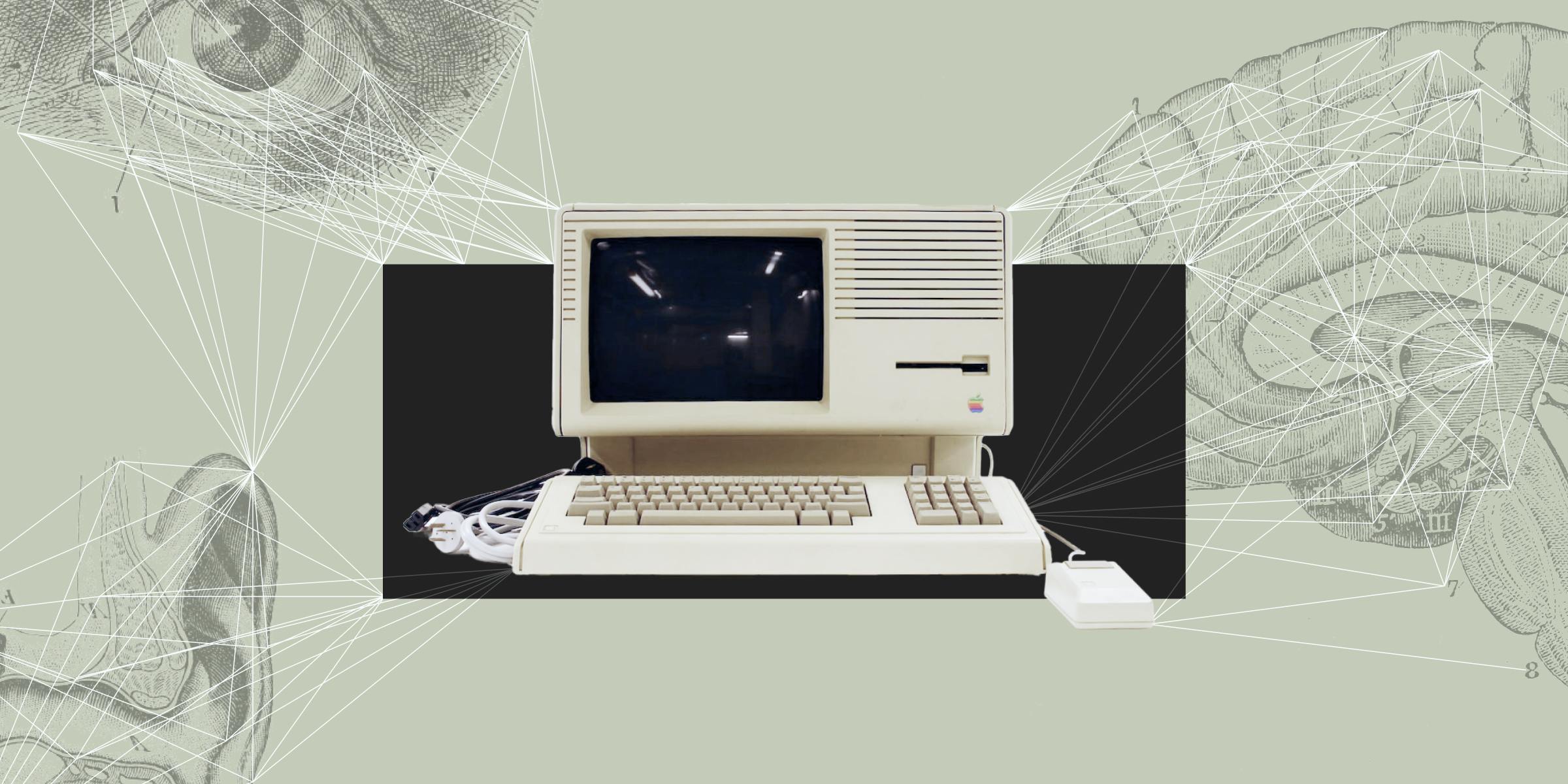Thesis
The number of photos shared over social media has tripled since 2013, with 14 billion images shared per day across WhatsApp, Snapchat, Facebook, and Instagram as of May 2025. Even on video-first platforms like YouTube and TikTok, content creators rely on thumbnail images to get users to click on the video. Creators and advertisers are constantly in need of image content, and supply has grown to meet that demand.
Stock photography is one commonly used solution for advertisers looking for images to help attract traffic or views. The stock photography market was valued at $3.3 billion in 2020. Free stock image sites host millions of photos — for example, Unsplash hosted 6 million photos, while Shutterstock, one of the largest paid stock photography sites, hosted over 1 billion files as of May 2025. Stock photos can cost between $0.20 and $20 per image, and with the risk of the same photos being overused, generative AI for commercial use becomes increasingly attractive.
Taking good quality photos or drawing photorealistic art takes skill, but anyone can type an idea for an image that AI can then generate. In its early days, AI image generation quickly attracted the interest of social media users; for example, Hank Green’s “cat” thread on Twitter attracted over 100K likes. Outside of social media, “AI art generator” received an average of 864K searches per month globally from August 2022 to August 2023, while “stock photo” only achieved an average of 94K searches in the same period. AI image generation is already being used to quickly produce concept art, make movie trailers, and even win art competitions.
Midjourney describes itself as an “independent research lab” known for producing a generative AI program that creates images based on text prompts. As the demand for online imagery continues to increase, Midjourney could offer a cheaper and more customized alternative to stock photography and reduce time spent on the brainstorming phase for contractors, game designers, and other artists alike. As of May 2025, Midjourney is a self-funded team developing diffusion models for image generation and editing tools, running Discord’s largest server with over 21 million members. Stripe recognized Midjourney as its most globally distributed business in 2024.
Founding Story
Midjourney was founded in 2022 by David Holz (CEO). Prior to founding Midjourney, Holz described himself as having been a serial entrepreneur since high school, when he ran a design business while still a student. He studied physics and math in college and before going on to pursue a Ph.D. in applied math, while working simultaneously at NASA and the Max Planck Institute from 2009 through 2011.
Holz eventually became overwhelmed and took a leave of absence from his Ph.D. program to move to San Francisco and start his first startup, Leap Motion, around 2011. The company developed hardware and software for human-computer interaction, namely gesture recognition and finger tracking for computer input. Leap Motion’s hardware was utilized by over 300K developers during its twelve years of operating under Holz’s leadership. In May 2019, the company was acquired by Ultrahaptics, now Ultraleap, for roughly $30 million or 10% of Leap Motion’s $306 million peak valuation in 2013.
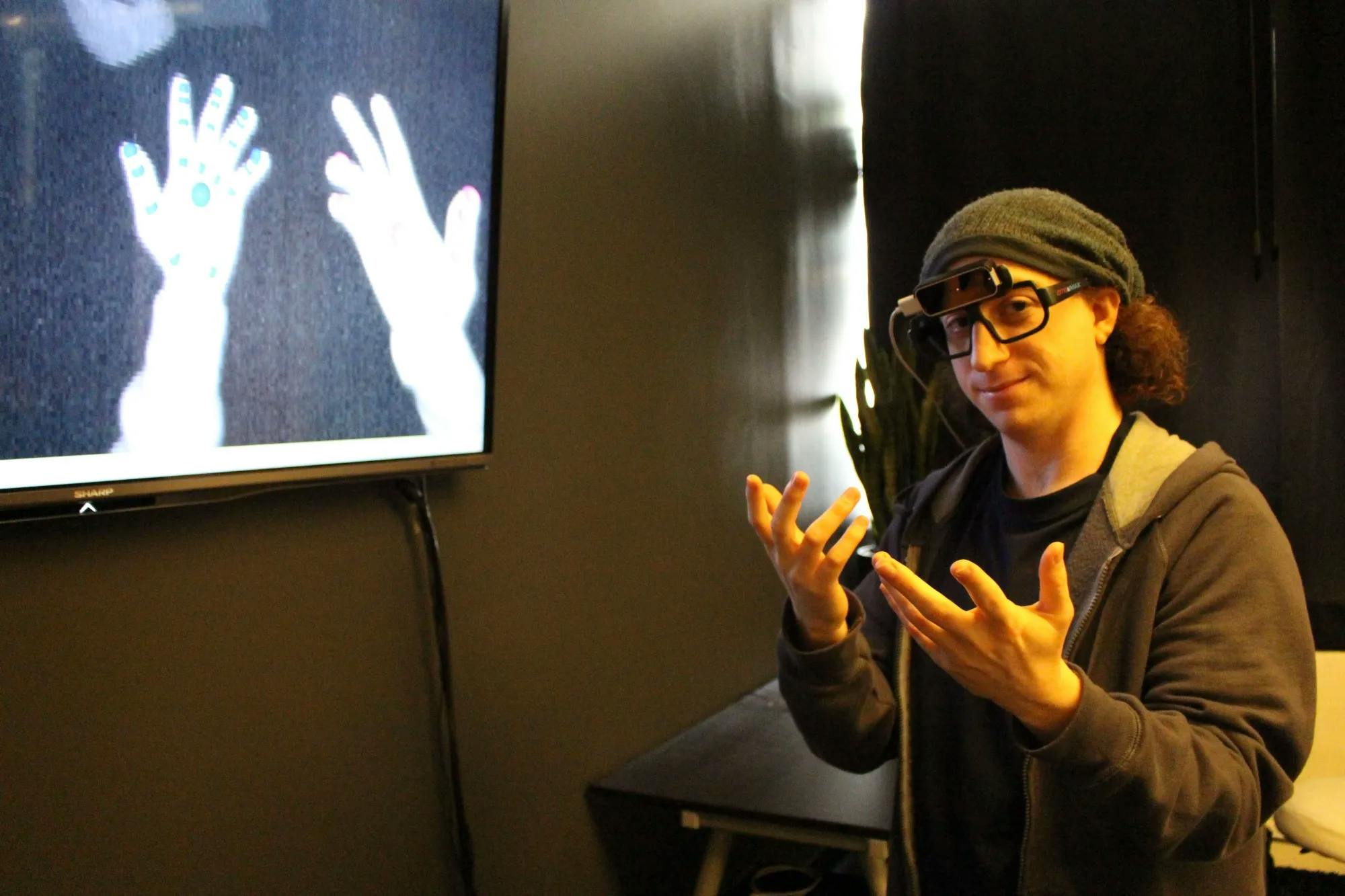
Source: Bloomberg
In August 2021, Holz left Leap Motion, seeking a change from large venture-backed companies. Amidst breakthroughs in natural language processing and generative adversarial networks (GANs), Holz recruited a team of ten engineers to start training diffusion models, which resulted in the launch of Midjourney. The independent lab launched its first private demo in September 2021. As Holz watched the first users test Midjourney, he began to realize the tool’s potential, wondering:
“What does it mean when computers are better at visual imagination than 99 percent of humans?”
By February 2022, Midjourney was released publicly in the form of a Discord bot within the Midjourney community. Hosting the product in Discord gave people the space to imagine together while also giving newcomers examples to explore. As Holz described in a November 2022 conversation with Stratechery’s Ben Thompson:
“I think that the Midjourney experience would not work at all if it was just talking to a chatbot in [a] room by yourself, but the second that it’s in a room with lots of people, it becomes really interesting.”
By August 2022, the Midjourney community had roughly one million members who Holz described as a “hive mind of people, super-powered with technology” — by May 2025, this number had reached 21 million, making it Discord’s most popular server. Ahmad Abbas, who led Apple’s hardware engineering team for the Apple Vision Pro, joined Midjourney as Head of Hardware in December 2023. In August 2024, Midjourney launched its own website and announced that it was expanding its hardware team, however, no further information on its hardware has been revealed.
Product
How Diffusion Models Work
Generative AI models need examples of objects like cars and cats before they are capable of generating new images of cats driving cars. As a result, Midjourney turned to the largest database of images it could find — the internet. Holz described Midjourney’s training data collection process as “a big scrape of the internet”.
Once images to be used as training data are collected, the data must be cleaned (removing duplicate, irrelevant, or bad data) and labeled. Although Midjourney performed its own “big scrape” to collect its own training data, it also utilized open-source training models such as the 2 billion image-text pairs from the English subset of CLIP’s open dataset created by the German non-profit LAION.
Since the release of Midjourney V4 in August 2022, Midjourney has been using a diffusion-based generative AI model. Diffusion models work by gradually adding noise to a sample image and then learning how to reverse that process, allowing them to create new images that resemble the original ones. After receiving a sample or training image, diffusion models go through a step-by-step process described below:
Forward Diffusion Process: The diffusion model starts by taking an input image and gradually adding Gaussian noise.
Noise Accumulation: The model continues to add more noise to the image. After each addition, randomized image sections are covered in noise until the original image is transformed into a noisy or grain-covered version. More noise will result in a more different generation, while less will produce a more similar generation to the original image.
Denoising Process: After adding the desired amount of noise, which Midjourney users can partially control with prompt weighting, the model learns to recover the original image by reversing the noising process.
Iterative Refinement: Denoising is performed iteratively, gradually reducing the noise level in the image. At each step, the diffusion model improves the image’s quality and ability to refine over time.
Training and Predictive Learning: The steps above are repeated for as many images in the training dataset as possible. The model eventually learns to predict the original image from the noisy image.
Generating New Data: Once the model is trained, it creates new images by passing random noise samples and generating the colors and shapes from the patterns the model picked up during training. This creates unique images similar to the training data but slightly different, resulting in various possible outputs.
If a diffusion model is given enough sample images of objects such as cats or cars, the model eventually learns what noise patterns shape a cat's face or a car's wheel. Once prompted, the diffusion model will combine the necessary noise patterns and generate an image of a cat driving a car. Since the noise patterns can be “denoised” or read differently, the same prompt naturally creates similar variations.

Source: Stable Diffusion Art
Using Midjourney
As of May 2025, Midjourney’s diffusion models can be accessed by users through its Discord server or directly through its website. The company constantly iterates on its models, releasing improved versions several times per year.
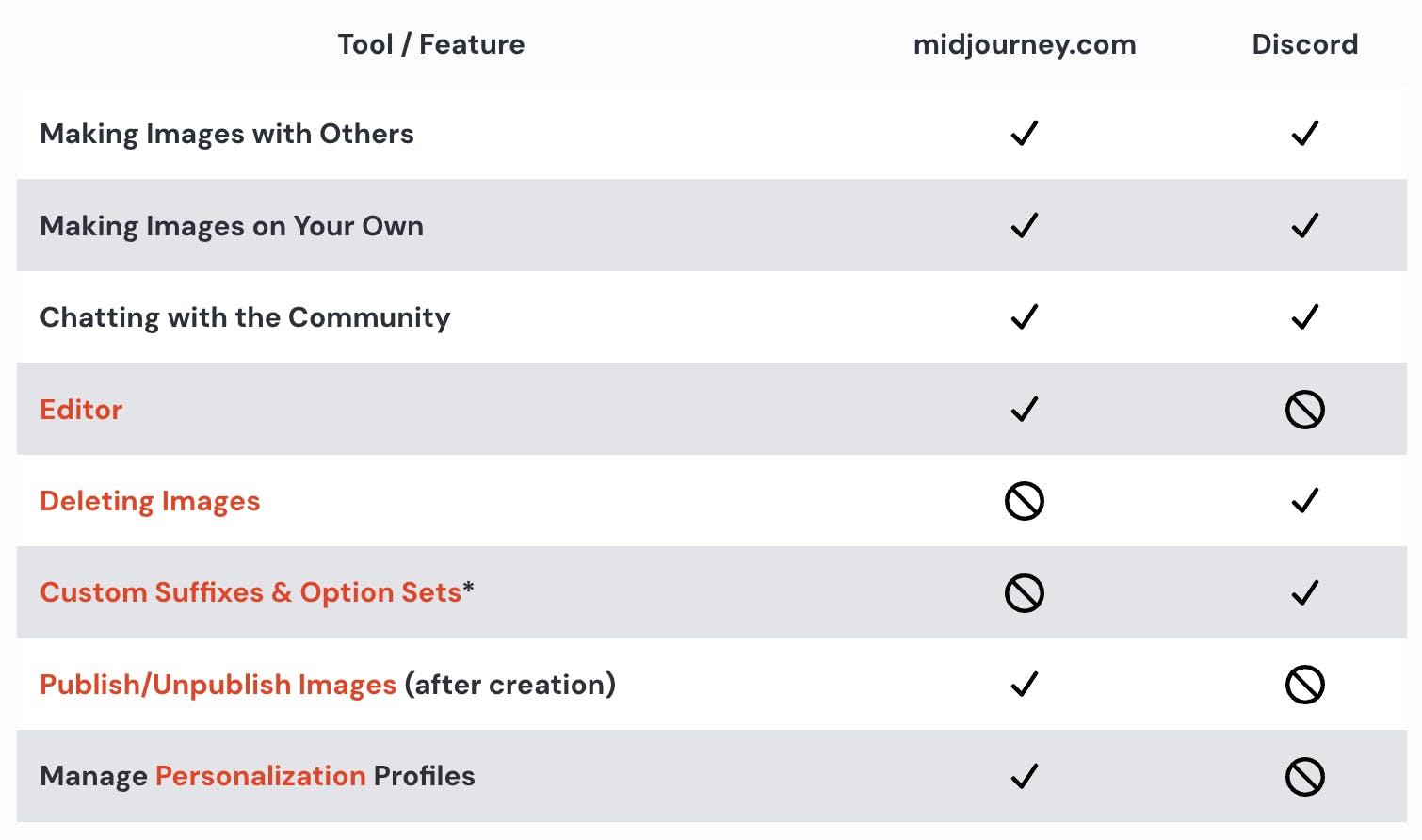
Source: Midjourney
Discord
On Discord, users prompt the Midjourney bot using the /imagine command, which returns four image variations. The process can take anywhere between a few seconds and many minutes, based on popularity, subscription plan, and rate limits. From there, users can upscale, re-roll, remix, or zoom out on outputs. Prompt syntax allows detailed control over attributes like aspect ratio, style strength, and model version. Tools such as custom suffixes and option sets are exclusive to Discord, as is image deletion. Editing tools like aspect ratio changes or panning must be applied one step at a time. Using reference images requires uploading them to Discord, retrieving the image URL, and manually entering it into a prompt. Despite its manual nature, Discord remains the social core of Midjourney, enabling users to collaborate, share feedback, and experiment in real time with the broader community.
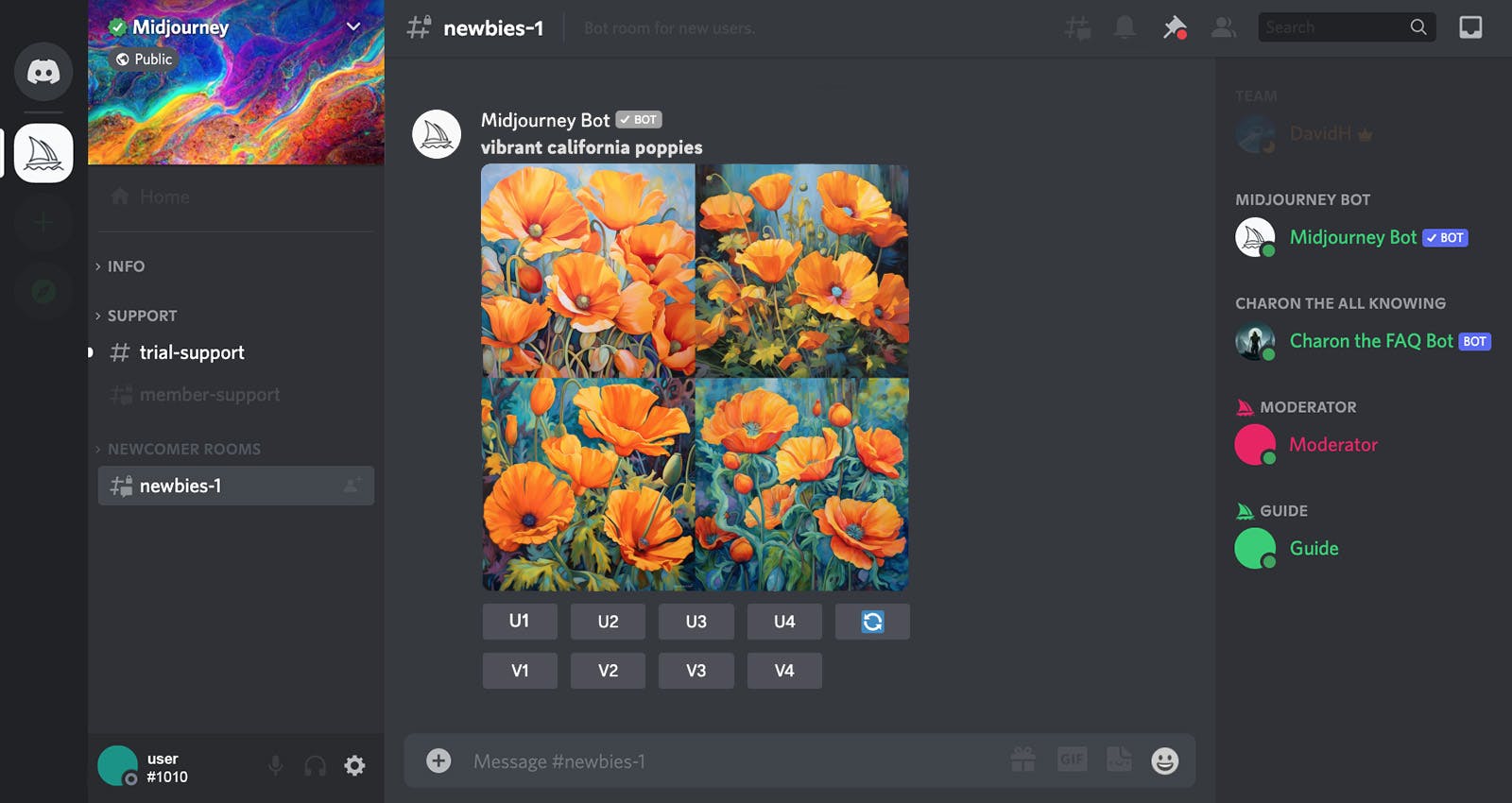
Source: Midjourney
Web Interface
The web interface offers a more structured and visual-first experience. Users can browse their personal galleries, explore public generations, and create prompts through a customizable panel. It supports (1) parameter controls for image size, stylization, model version, such as standard, photorealistic, or anime-focused Niji, and (2) generation speed, including Relax, Fast, and Turbo modes. A built-in editor consolidates tools like crop, pan, erase, restore, and scale into a single workspace. Inpainting via the Vary Region tool is embedded directly into the editor, enabling smoother image adjustments. Reference images can be added with a click and designated as image prompts, style references, or character guides. Users can also reuse previous prompt text, image references, and style settings through contextual tools within each generation, streamlining the process of iteration and variation.

Source: Midjourney
Model Versions and Capabilities
In December 2024, Midjourney launched Patchwork, a multiplayer worldbuilding tool set on an infinite canvas. Patchwork allows users to generate characters, describe scenes, and build connections between elements in a shared visual space. Up to 100 users can edit a single world simultaneously, with all imagery and text centrally stored within the workspace. Each character or asset can be visualized multiple times using Midjourney’s model, supporting iterative storytelling and collaborative design.
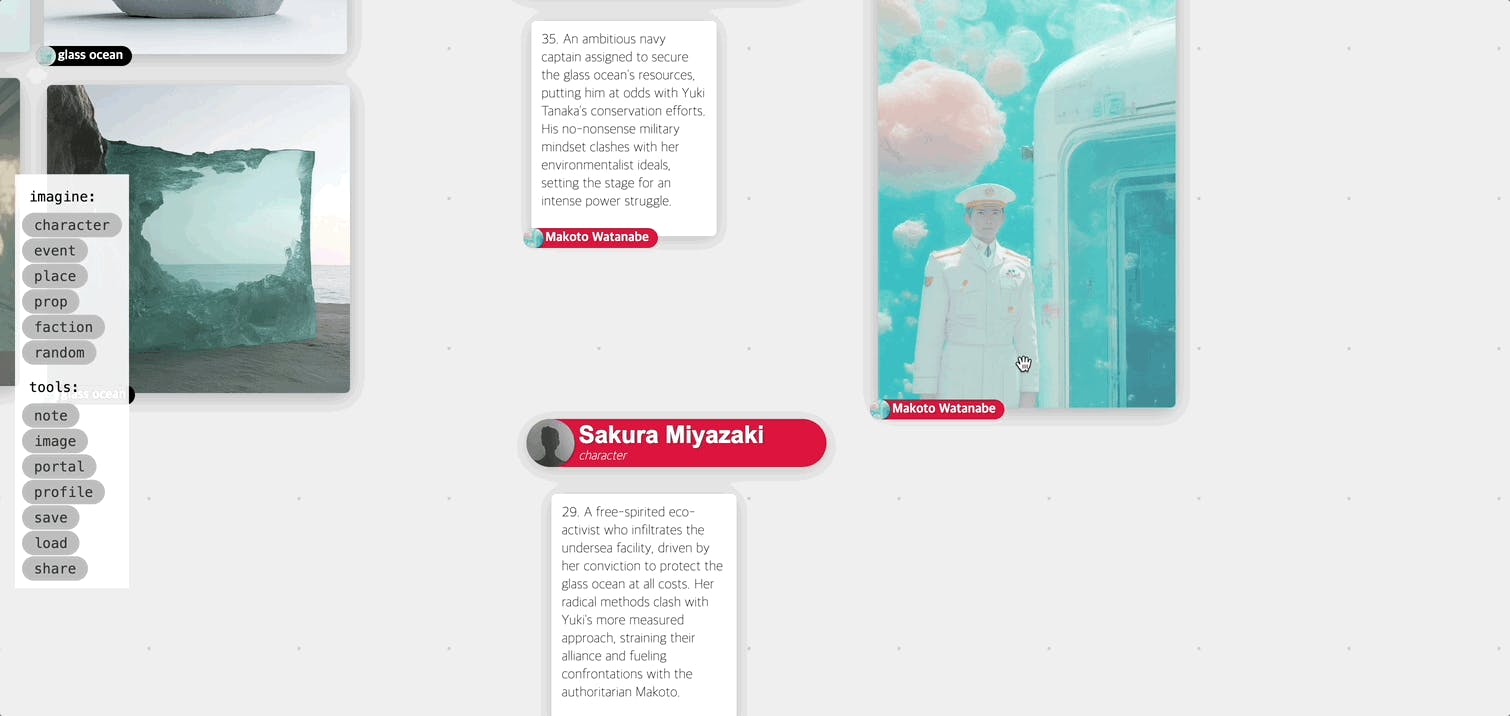
Source: Midjourney
Midjourney’s Version 7 was released in April 2025, bringing improvements in output quality, especially in rendering hands, faces, and fine object details. This version also introduced a trio of workflow enhancements. Personalization enables users to train the model on their preferences through image rankings or moodboards, tailoring generations to their unique style. Omni Reference allows users to carry specific visual elements across different prompts, preserving consistency across outputs. Draft Mode offers a faster, lower-cost generation option built for rapid prototyping, with prompt assistance available through real-time text or voice interaction.
Market
Customer
In September 2022, Holz estimated that only 30% to 50% of Midjourney’s users were using the tool as professionals, with the rest using it in a personal capacity. In March 2023, the company stopped offering free trials, which may have reduced the number of casual users. As of August 2023, users must subscribe to Midjourney to generate their own images, but people can join the community and export other people’s creations without subscribing.
In April 2025, 68% of Midjourney’s traffic was direct, while 29% was organic, demonstrating that the company is benefiting from unpaid customer acquisition; this helped the company achieve profitability just six months after launch. Although the company has not released any updated information about its customer base as of October 2023, Midjourney’s customers are likely to fall into two buckets based on use case: advertisers and artists.
Advertisers: Instead of paying for generic stock imagery, which can be particularly limiting to companies in niche markets, advertisers could turn to Midjourney to generate customized images that can easily be revised without paying for a stock photo license or photographer. Midjourney’s aspect ratio remix and inpainting options may be particularly helpful for teams who seek to reuse content across different social platforms and devices by making modifications or edits.
Artists: Although some believe AI art exists in competition with artists, Holz said that artists use Midjourney to be more “explorative in the beginning, coming up with lot a of ideas in a short amount of time.” Game designers and concept artists could also use Midjourney creations as a base before jumping into modeling and rigging. In addition to helping artists settle on an idea before spending hours drawing, molding, or photographing, others have used Midjourney as an input to their work. A graphic designer could generate background textures while a photographer could generate new skies.
Before the advent of generative AI tools like Midjourney, artists relied on sites like Pinterest, Dribble, or stock photo sites to gain inspiration. Although such methods may give artists all the pieces, only generative AI has the potential to help artists combine pieces during the inspiration phase. Artist adoption varies from creator to creator, with some suing against AI art and others embracing it, but Midjourney's value proposition is likely to be clear to creators or artists who are early adopters.
Market Size
Midjourney’s total addressable market can be benchmarked against Adobe, the dominant player in creative software. Adobe estimated its TAM at $205 billion in 2024, projecting it to grow to $293 billion by 2027. This includes creative professionals, enterprises, and casual users across desktop, mobile, and web-based tools – an audience Midjourney increasingly serves through both its Discord interface and web platform. As Midjourney expands into editing, personalization, and collaboration features like Patchwork, its product surface is converging with Adobe’s Creative Cloud.
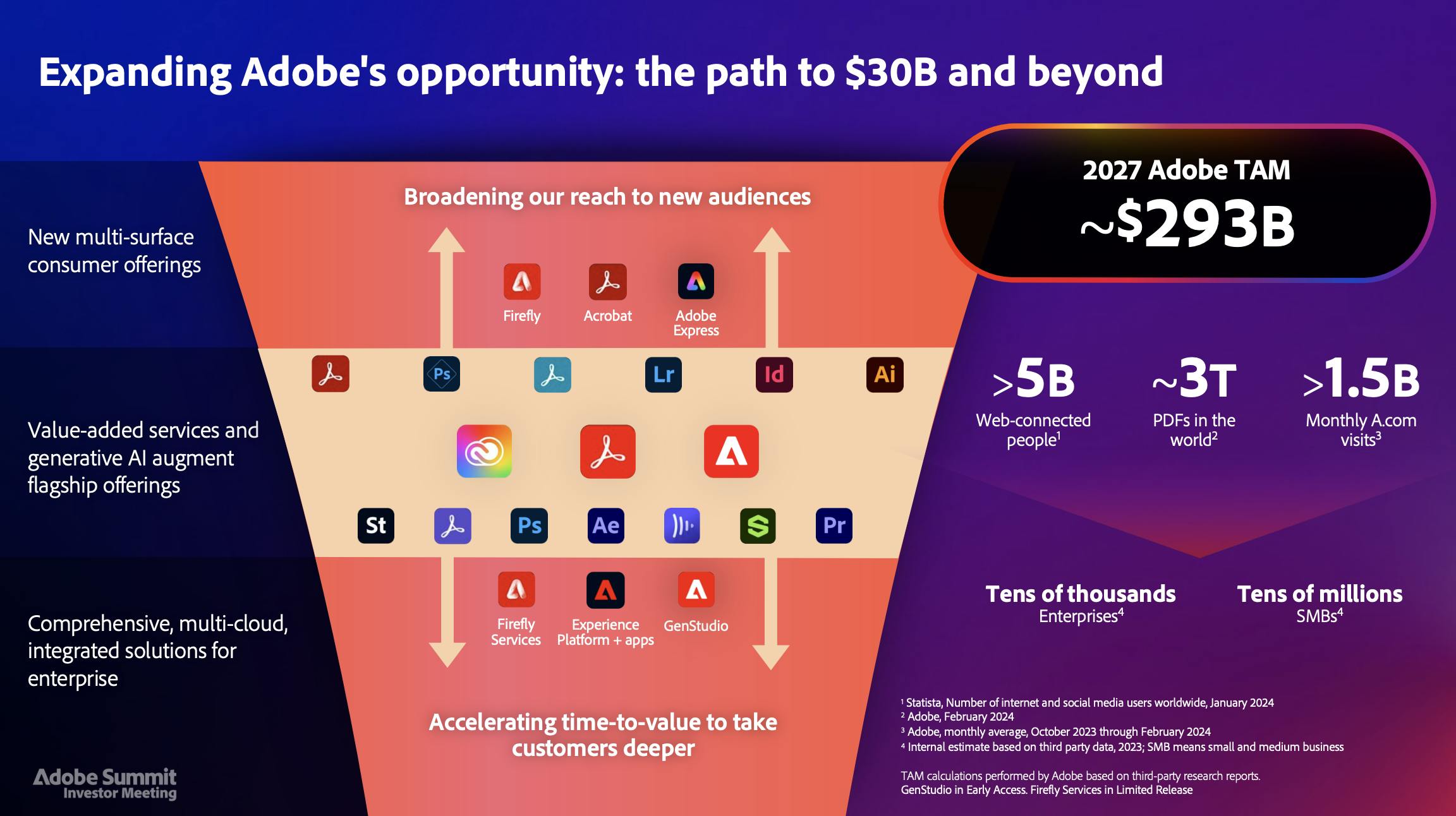
Source: Adobe
The addressable market of generative AI for images may also be compared to the stock photography industry since it may absorb some or even most of this market. Before the release of mainstream AI image services, the global stock photography market was valued at $3.3 billion in 2020 and was expected to reach $4.8 billion by 2028. Across the many use cases for AI image generators, there are millions of potential customers. In 2020, there were 32 million bloggers in the United States, representing a large audience of individual creators who may consistently need cover art. Although statistics on total social advertising agencies are limited, Facebook Data reported seven million active advertising partners in February 2019.
Competition
The generative image market is shaped by two types of players: startups building AI-native tools from the ground up, and incumbents adapting their legacy creative ecosystems to include generative capabilities.

Source: Artificial Analysis
Startups
OpenAI: Founded in 2015, OpenAI is a developer of general-purpose AI models, including the GPT series for language, Sora for video, and DALL-E for image generation. While OpenAI is best known for ChatGPT, its viral chatbot that reached 100 million users within two months, its broader platform powers a wide range of AI applications through APIs and integrations. As of May 2025, OpenAI raised a total of $61 billion and is the second most valuable private company in the world.
While DALL-E was its first major image model, the March 2025 update of GPT-4o introduced native image generation capabilities directly within the ChatGPT interface. It also became the top-ranked diffusion model on the Artificial Analysis leaderboard as of May 2025, surpassing both Midjourney in benchmark image quality and coherence. Compared to Midjourney, OpenAI offers broader accessibility and developer tooling. GPT-4o and DALL-E are available via ChatGPT and API, allowing for easy integration into external workflows. Midjourney maintains a lead in stylistic flexibility and artistic control, but OpenAI’s unified multimodal stack positions it as a comprehensive creative AI platform and a structurally advantaged competitor.
Stability AI: Stable Diffusion was released publicly in August 2022; its development was funded by Stability AI, a startup that was founded in 2019. Stability AI has raised a total of $256 million in funding as of May 2025. Its $25 million convertible note in June 2023 reportedly occurred after the startup failed to raise equity funding at a $4 billion valuation and after the publication of a Forbes article that asserted that Stability AI founder Emad Mostaque had exaggerated Stability AI’s role in Stable Diffusion’s origin and that its source code was written by a different group of researchers. As of May 2025, in addition to its image model, Stability AI offers audio, video, and 3D models.
Ideogram: Founded in 2022, Ideogram developed a text-to-image model that excels at producing text elements within images, making it particularly useful for branding, advertising, and design applications that require coherent lettering and stylized typography. The platform’s interface also allows users to fine-tune parameters for font style, layout, and color palettes, balancing between creativity and control. As of May 2025, Ideogram has raised a total of $96.5 million in funding over two rounds.
Runway: Founded in 2018, Runway offers collaborative video and image editing software. In addition to real-time editing, Runway Research's AI tools offer powerful prompting, editing, and image-to-video software. As of May 2025, Runway has raised $544 million in funding. Its $308 million Series D round in April 2025 valued the company at $3 billion. Runway offers a free trial with limited functionality, and its cheapest subscription plan starts at $12/month per user. Runway's real-time collaboration is available throughout the full design process. Runway focuses on professional and enterprise use, while Midjourney remains more targeted towards individuals. Even though Runway offers its own AI image generation, some users still use Midjourney for image generation, for example, combining both tools to create a movie trailer.
Incumbents
Adobe: Founded in 1982, Adobe has developed over 60 software applications in its Creative and Acrobat Suite to power the daily workflows of artists and enterprise customers. As of May 2025, Adobe has a market cap of $177 billion. Although AI has powered Adobe tools like Content-Aware Fill since 2019, Adobe officially joined the AI race with the release of Firefly in March 2023. Firefly, a generative AI tool, was added to the Creative Cloud suite, giving users the ability to generate images, vectors, videos, and even 3D.
Adobe's Firefly is designed to incorporate AI into the established workflows of users who are already accustomed to using Adobe’s product suite. This means that Adobe users can leverage Firefly with familiar tools like the “Pen” tool in Photoshop, enabling users to define specific areas for AI-driven editing. Unlike Firefly with its integration across various Adobe applications, Midjourney’s primary purpose is to generate new images rather than precisely edit or modify existing ones, although it has broadened its functionality to include editing since it launched. Since Firefly is wrapped into Creative Cloud pricing, the $54/mo price tag may make Midjourney a more affordable alternative for individual creators or designers not looking for functionality beyond basic image generation and editing.
Shutterstock: Founded in 2003, Shutterstock is a stock media site, offering photos, videos, audio, graphic design templates, and 3D assets as well as some image editing and media planning tools. In May 2023, Shutterstock released its own AI image generator and revealed a waitlist for a smart design assistant. Shutterstock offers more media types compared to Midjourney, which only offers images. Shutterstock’s market cap was $650 million in May 2025.
Although Midjourney has a general advantage over stock images in terms of user control and flexibility, Shutterstock’s generative AI tool and AI design assistant may satisfy existing Shutterstock users; it may even be able to leverage a distribution advantage with its vast SEO reach. It’s easy to find a Shutterstock image after a quick Google Search, while, by contrast, a new Midjourney generation is much more difficult to discover. Midjourney’s lack of off-platform access may also put it at a disadvantage compared to Shutterstock’s web-based generator.
Google: Founded in 1998, Google has long been a leader in foundational AI research, with breakthroughs like Transformers and AI image classification originating in its labs. While Google’s AI infrastructure powers internal products like Search, Ads, and YouTube, it has also made moves into consumer-facing creative tools. In 2023, Google launched Imagen, a text-to-image model focused on photorealism, and later integrated it into products like ImageFX and Bard. In May 2024, Google released Imagen 3, which has been deployed across Google’s wider ecosystem and powers the image generation capabilities of Gemini, its flagship AI model. As of May 2025, Google’s market cap was $2 trillion.
Business Model
Midjourney generates revenue through its tiered subscription models, offering different plans ranging from $10/month for the most basic plan to $120/month for the highest tier, and it encompasses various features such as Fast GPU Time, concurrent jobs, and privacy control.
All plans offer unlimited commercially licensed generations depending on processing availability, but they differ in generation speed. While default "relaxed" generation times can vary based on usage, usually taking no longer than a few minutes, Fast GPU Time aims to achieve generation in under a minute or two. The distinction in Fast GPU Time, concurrency, and privacy control across different plans creates an incentive for users to opt for higher-tier subscriptions.
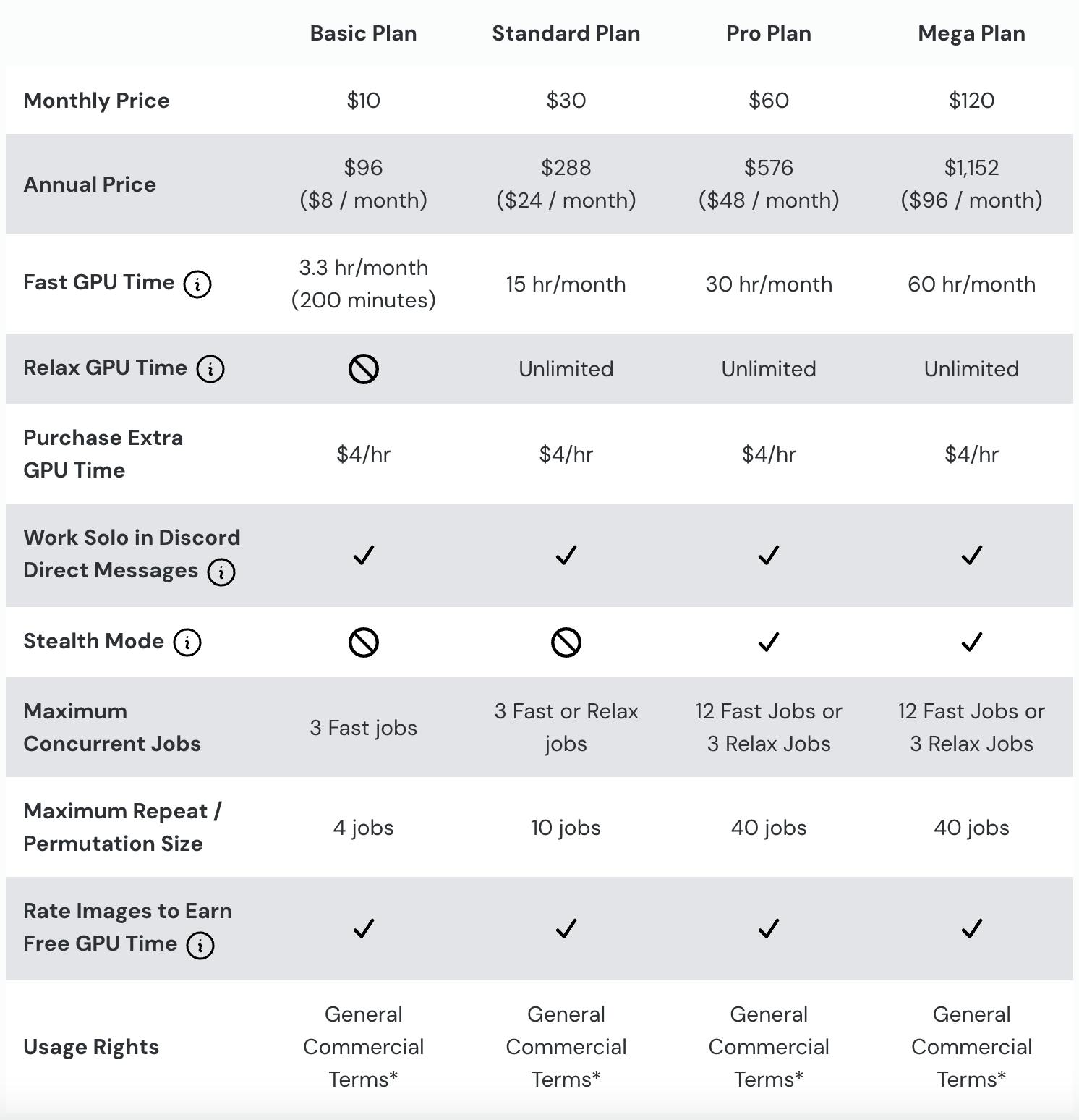
Source: Midjourney
Even as a software company using cloud services, Midjourney relies on an asset-heavy model given the significant investment in infrastructure required to support an actively training AI service used by millions of people. In addition to supporting its small team, Midjourney’s greatest expenses likely fall into three categories: data collection, data cleansing & training, and active server costs.
Data Collection (Web Scraping): Building and running an efficient web scraper can be expensive, with some services charging around $3.33/hour. Let’s say Midjourney scraped only a week’s worth of internet photos — roughly 20 billion photos — with each photo only taking 10 milliseconds to scrape. This would amount to 55K hours of scraping and at $3.33 per hour, cost around $185K just to collect one week’s worth of photos. This does not include paying for proxies to prevent IP blocking, as many sites auto-block mass web scraping, nor server costs specifically for running the data collection process.
Data Cleansing & Training Neural Networks: Once data is collected, it still needs to be cleansed. Server costs for training a diffusion model with a large data set also need to be considered. Training a small-scale General Adversarial Network, or an older approach to generative AI images, on Google Cloud can cost between $2.5K and $3.1K per month, for example. Stable Diffusion itself was trained using 256 Nvidia A100 GPUs on Amazon Web Services for a total of 150K GPU hours, at a cost of $600K.
Active Server Costs: In an interview with The Verge in August 2022, Holz described the computing power required for generating images like this:
"Every image is taking petaops. So 1000s of trillions of operations. I don't know exactly whether it's five or 10 or 50. But it's 1000s of trillions of operations to make an image. It's probably the most expensive … if you call Midjourney, a service – like you'd call it a service or a product – without a doubt, there has never been a service before where a regular person is using this much compute.”
A petatop means 10^15 operations per second for every image generated. Let’s assume that generating one image requires five Petatops (5 * 10^15 operations). Modern GPUs can perform trillions of operations per second. For example, the NVIDIA Tesla V100, widely used for deep learning, offers about 15 TeraFLOPs for certain types of calculations.
Even with looming server costs, Holz told The Verge that the company had become profitable in August 2022, just six months after its public launch.
Traction
Midjourney’s Discord server surpassed 21 million members in 2025, making it the largest community on the platform. On the web, Midjourney recorded over 13 million visits in April 2025 alone. Its Reddit community has grown to over 1.7 million members, placing it among the top 500 subreddits globally. In 2024, Stripe recognized Midjourney as the most globally distributed merchant on its platform, with customers spanning more unique countries than any other business. Stripe gifted CEO David Holz a custom CRT monitor showcasing a live map of Midjourney’s global subscriber base.
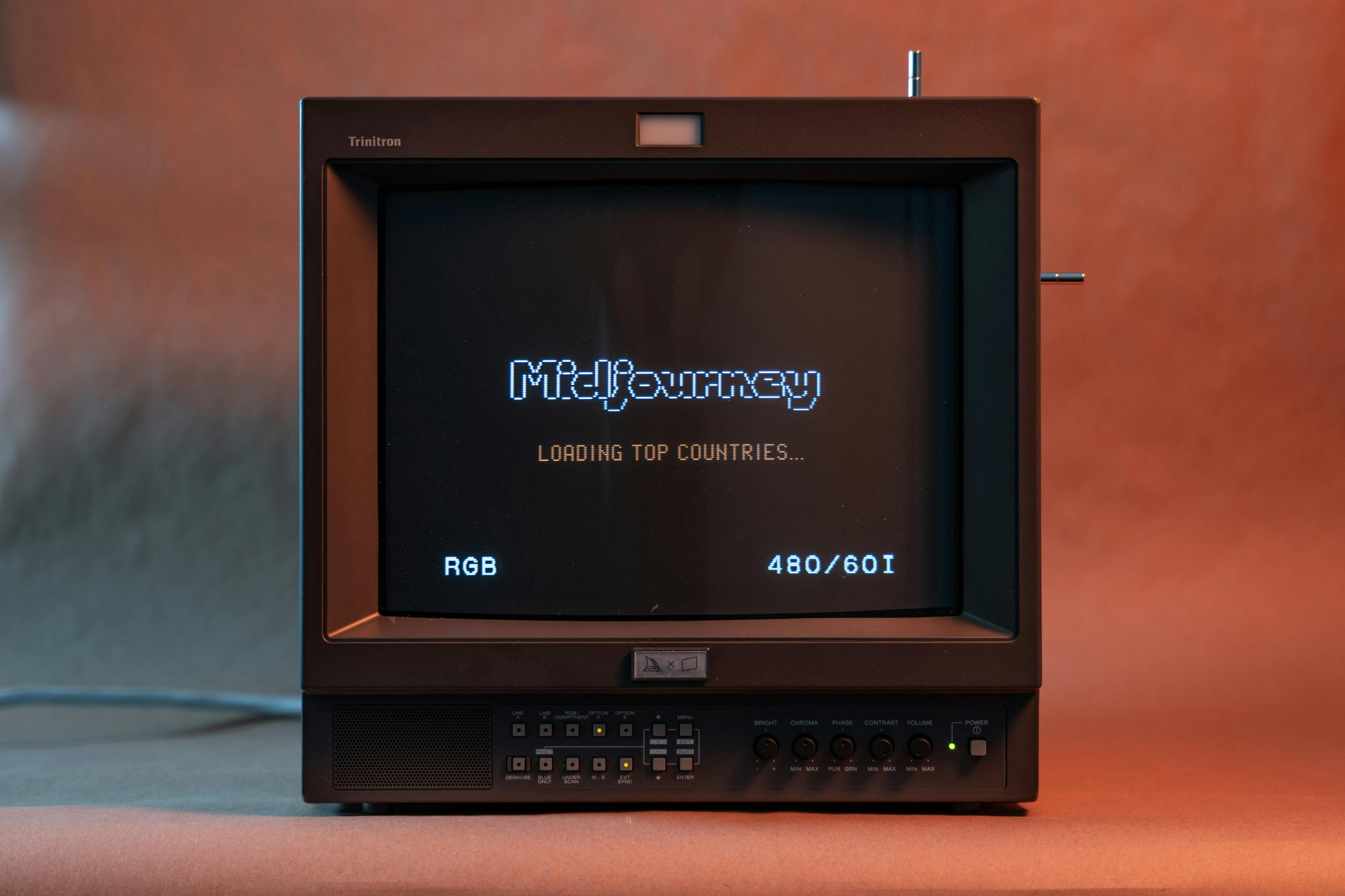
Source: David Holz via X
Midjourney reportedly generated $200 million in revenue in 2023 and is estimated to be operating at $500 million ARR as of May 2025. What makes this particularly notable is that Midjourney has done so without raising outside capital and with a team of just ~40 employees. It is frequently cited as the leanest high-growth AI company in the world, and a standout example of product-market fit in the consumer AI space.
In August 2024, Midjourney announced it was entering the hardware space. The team hired Ahmad Abbas, former Hardware Engineering Manager on Apple’s Vision Pro and a former colleague of Holz at Leap Motion, to lead the new division. While specific product details haven’t been specified, the company has posted open roles for its San Francisco-based hardware team and hinted at ambitions tied to spatial computing.
Valuation
As of May 2025, Midjourney has not raised any external funding and appears committed to remaining independent. Holz has compared it to Craigslist. In August 2022, Holz explained the reasoning behind this approach:
"We're like a self-funded research lab. We can lose some amount of money. We don't have like $100 million of somebody else's money to lose. To be honest, we're already profitable, and we're fine.”
Key Opportunities
Product Expansion
Midjourney has steadily broadened its toolset, from basic image generation to advanced editing (inpainting, remixing, zooming) and style personalization. Yet, it remains primarily a tool for the early stages of creative workflows. There’s a clear opportunity to extend downstream. For example, vector output could enable use in logo design or illustration, while support for animations or native image-to-video tools would open up motion graphics use cases.
Runway’s image-to-video tool has enabled users to create cinematic movie trailers, all without shooting a second of real video. Midjourney could likewise offer its own in-house image-to-video support or explore a direct partnership with Runway, such as syncing a user’s Midjourney gallery to their Runway folder assets. In January 2024, Holz announced Midjourney was working on its video models, however, no formal releases have been announced as of May 2025.
API Access
Midjourney does not have an official API, and its subscribers are individuals, not developers or other startups. By releasing its model for developers and charging per use, just like OpenAI’s API, which charges $0.01 to $0.17 per image, Midjourney could capture more customers without significant internal development strain. Offering APIs could potentially let Midjourney’s community handle core features, like image editing or even website-hosted versions, while still generating revenue for Midjourney.
Key Risks
Intense Competition Within Existing Workflows
With nearly 30 million customers using Adobe Creative Cloud, Midjourney could be viewed as just another tab or application to boot up during the design process. As Adobe Firefly expands early access, creators may find it more convenient to use the tools within their main design interfaces, instead of constantly switching back and forth. Midjourney’s existence within Discord and lack of off-platform use create friction for customers even if they do not use services from Adobe Creative Cloud. Searching “AI” in Figma’s community plugin center returns more than one hundred results already, as of August 2023, all offering quick, in-app AI solutions.
Copyright Battles
Regulatory risk has become a defining challenge for generative AI companies, particularly those operating without formal data licensing agreements. In January 2023, a copyright and trademark claim was filed by a group of artists against Midjourney, Stability AI, DeviantArt, and Runway. In August 2024, a federal judge ruled that this lawsuit could proceed. For Midjourney specifically, the court found that its use of a 4,700-name “Style List”, which allowed users to prompt in the style of real artists without their consent, could constitute false endorsement.
While some allegations were dismissed, the judge’s decision allowed discovery to move forward, giving plaintiffs a chance to access internal records from the companies involved. The implications go beyond Midjourney – if courts rule that training on copyrighted images or enabling stylistic mimicry violates IP law, companies without licensing deals may be forced to overhaul their models or pay compensation. This creates a significant divide between startups like Midjourney and Stability, and larger incumbents like OpenAI and Google, who have signed multimillion-dollar licensing agreements to de-risk their datasets.
Summary
Midjourney rests in an incredibly competitive market, with other generative AI image products spawning from enterprise creative software companies with a robust suite of tools and millions in funding to seamlessly integrate into their already popular software. Midjourney grew to 21 million members as of May 2025, making it the largest community on Discord. The company’s high-quality visuals have impressed mainstream users. The high-quality image generations and fast growing membership allowed Midjourney to become profitable just six months after launch. Midjourney’s small team has promising progress so far, but will need to rapidly improve and expand its product offerings to stay ahead of larger, more robust, generative AI companies.

